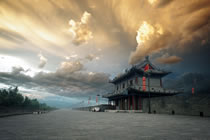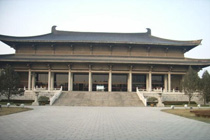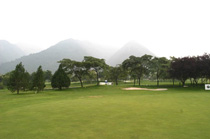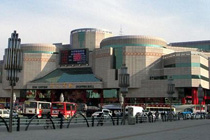Xi’an is a civilized ancient city with a long history. Throughout the history of China, ten dynasties have set their capital city in Xi’an, which covers a history of over 1000 years. It makes Xi’an a famous ancient capital city with the most number of dynasties establishing capital city here and the longest history. Countless ancient architecture and valuable historical relics have been preserved above and under the ground, including the Banpo Museum, the Fenghao Historic Site, the E’pang Palace Historic Site, the Mausoleum of the First Emperor of Qin, the Daming Palace Historic Site, the Great and Small Wild Goose Pagoda, the Zhaoling Mausoleum, the Qianling Mausoleum, the Ancient City Wall, the Bell & Drum Tower, the Forest of Steles, and the Xi’an Office of the 8th Route Army, to name just a few. Now please allow me to take to the extremely beautiful and pleasing Huaqing Hot Spring on Lishan Mountain!
Covered in exuberant green trees, Lishan Mountain looks like a beautiful dark horse from afar. At the foot of the mountain is the famous stunning Huaqing Hot Spring. Hot spring gushes out into the pool, bringing up green ripples. A great many well-designed pavilions are dotted among the green trees like sparkling gemstones. The “Chiang Capturing Pavilion”at the halfway of the mountain was the place where Chiang Kai-shek was captured by generals Zhang Xueliang and Yang Hucheng, which is known as the famous “Xi’an Incident”.
The most distinctive feature of Xi’an is that it has preserved numerous cultural relics and traditions as the capital city of so many dynasties in the history. To become recognized in the world, the nation must possess advanced architectural culture, which is comprised of scientificity, progressiveness and originality. Embodiment of Xi’an characteristics must be reflected in the geographical location, historical background, and great boundary. Located in the Central Guanzhong Plain, Xi’an rests against Qinling Mountains in the south and crosses over the Weihe River in the north and has been known for the famous scene of “eight waters flow around Chang’an”. Its city structure is unique as well. Xi’an City has a square-shaped city contour with distinctive axes, particularly the direct south-north road network. Xi’an enjoys unique city texture. The historical photos and prototypes handed down generations after generations reveal the distinctive city texture of Xi’an City, which unfortunately has been severely damaged. Texture is actually the base tone of a city. Xi’an City also boasts of historical streets and substantial landmark buildings.
The Unique characters of Xi’an may be summarized by its “momentum, appearance, charm and culture”. “Momentum” refers to its grandeur and magnificence, and the goal to carry forward the precise and scientific check-board design from Zhongnan Mountain to Weihe River region. “Appearance” aims at the sense of dignity and profoundness, which is reflected as modesty and elegance on architectures, complementing with the grandeur of the ancient city. “Charm and culture” aim to highlight the cultural connotation of the ancient city in terms of its rhythm and spirit, which combines the buildings with the unique culture of the city.
Since the Opening and Reform Policy, the design of Xi’an City has been given tremendous regional features. In spite of the achievements it has made, there are still a lot need improving. First of all, it is necessary to make some fundamental changes in order to highlight prominent traditional structure. The traditional structure of this ancient city has not only recorded its construction and layout characteristics of traditional structure but also contained the close relationship between the city and the nature, society and culture. It is not acceptable to focus on external appearance only and totally ignore historical and cultural significance. The traditional structure of Xi’an City is subject to the self-contained axis system. The main axis of the capitalcity for Qin and Han dynasties can still be vaguely seen through the various historical sites and its unique landforms; the main axis of Chang’an City for Sui and Tang Dynasties is more definite; and the axis system of Song, Yuan, Ming and Qing Dynasties are still well preserved. Planners are well aware of this and have been careful in planning the city structure, which I think is a very good start. The axis system of the ancient city must be cherished and preserved as an integral part of the traditional city structure and shall be considered as the great historical treasure uniquely found in Xi’an only. They successfully combine the mountains, waters, and the city together, have great functional and academic significance,and also contain extremely rich cultural philosophy. During the city design process, only when the outstanding historical cultures and traditions are taken into account can we provide the ancient city with more original ideas and more unique style. Secondlywe need to protect and restore the pure and genuine history of the city. The history of an ancient city is comprised of multiple elements with the architectures, streets and landscape gardens being the major components. The style and design of the architectures, streets and landscape gardens reveal the varied and colorful regional culture in different ages. As the capital city of 12 dynasties, the architectural styleof Xi’an City is a consolidation of the features of Zhou, Qin, Han, Tang, Song, Yuan, Ming, and Qing Dynasty. Take the old Xi’an city design for example; the existing ancient architectures are mostly remains of Ming and Qing Dynasties. Whereas the old Xi’an City is a continuation of the Tang Royal City, which makes the historical and architectural style of old Xi’an City rather controversial. Personally I think the new buildings in the old city have been provided with more modern architectural style. In certain areas, certain buildings must strictly stick to one particular style. It can be Ming, Qing or Tang style, but has to be pure without being mixed. With regard to city planning, the cultural meaning of each street and section is of great importance. We recommend interdisciplinary study and scientific verification instead of allowing one person to have the final say. In terms of architecture, the style of architecture reveals the professional and cultural quality of a city and a region and shall never be taken for granted. Thirdly the integration of featured space must be consistent. Throughout the history of Xi’an City, the iconic locations and landmark buildings are all selected and designed at the intersection between axis and axis and the joint of waters, rivers and the landforms. These intersections and joints are usually known as “nodes” in modern city design, some of which have been listed as key sections for urban planning, protection and development, such as the Four-gate Square at the Xi’an City Wall, the Great Wild Goose Pagoda and South&North Square, and the Mingdemen Relics Park. During the progress of urban modernization, the reconstruction and integration of urban spaces is a must-have approach. In addition, organizing distinctive space by making use of ancient architecture and historical sites may achieve more with less in highlighting its image of being an ancient city. For which purpose, we need to make good use of them, protect them, and develop them. The integration of those featured spaces must show “the history and the future”, keep and develop their original image, structure, and historical culture instead of “making overthrowing changes”. Fourthly creation of cultural environment must maintain high grade and taste. Xi’an is the capital city of two dynasties and a prosperous city of Zhou, Qin, Han, and Tang Dynasties. However after the Tang Dynasty, China’s political center gradually moved eastward and Xi’an was changed from a capital city into a prefectural city, which made Xi’an a large prefecture described in “The Abandoned Capital” by some writers. If this trend had been continued, Xi’an would not have been recognized as an “ancient city” but an “abandoned town”. However, creation of cultural environment shall not be the responsibility of designers and architects only. It requires the efforts of the entire society. Nevertheless, the entire city design must be based on the fact of it being an ancient city and the guiding philosophy of endeavoring to create high taste and restoring the great prosperity of Han and Tang Dynasties. This will require further study, research, and recognition of the remarkable history of the ancient city, particularly its architecture and culture. Our studies on Zhou, Qin, Han and Tang Dynasties are still very basic. With the progress of archaeological excavation and more in-depth study about historical literature, it will take a while for us to improve our understanding about the ancient city and our designers and architects to improve their cultural know-how. Geographical features not only reveal natural factors but also are embodiments of the local culture. Again, to highlight the geographical features in the urban design requires our designers and architects to improve their own architectural culture literacy, which is an honorable duty and historical task of all our ancient city workers.
 Xi’an is not only a historical and culture city, but also a trendy city permeated with modern tempo
Xi’an is not only a historical and culture city, but also a trendy city permeated with modern tempo
 Ancient capital Xi'an, the tourism dream is over the time
Ancient capital Xi'an, the tourism dream is over the time
 The cultural and historical significance of the area, as well as the abundant relics and sites, help Xian enjoy the laudatory title of 'Natural History Museum'
The cultural and historical significance of the area, as well as the abundant relics and sites, help Xian enjoy the laudatory title of 'Natural History Museum'
 Countless ancient architecture and valuable historical relics have been preserved above and under the ground
Countless ancient architecture and valuable historical relics have been preserved above and under the ground
 Culture Qin:Museum of Qin Terra-cotta Warriors and Horses
Culture Qin:Museum of Qin Terra-cotta Warriors and Horses
 It is the first multi-functional museum complex which integrates museum, monuments and park
It is the first multi-functional museum complex which integrates museum, monuments and park
 As the symbol of the old-line Xian, Big Wild Goose Pagoda is a well-preserved ancient building and a holy place for Buddhists
As the symbol of the old-line Xian, Big Wild Goose Pagoda is a well-preserved ancient building and a holy place for Buddhists
 Tang Paradise is located in the Qujiang Resort, southeast of the Xian City, Shaanxi Province
Tang Paradise is located in the Qujiang Resort, southeast of the Xian City, Shaanxi Province
 Grand Park Hotel Xi’an
Grand Park Hotel Xi’an
 Xi'an Train Station is ranked as Class A by the nation standard with all the modern facilities
Xi'an Train Station is ranked as Class A by the nation standard with all the modern facilities
 the Chinese dumpling has a long history and is an essential part of celebra-tory meals such as those prepared for the Chinese lunar Spring Festival
the Chinese dumpling has a long history and is an essential part of celebra-tory meals such as those prepared for the Chinese lunar Spring Festival
 This is the famous Halal snacks street in ancient Xi’an City and the only professional food market that runs exclusive Halal food
This is the famous Halal snacks street in ancient Xi’an City and the only professional food market that runs exclusive Halal food
 the Grand Hongkong Restaurant has won many honors and titles
the Grand Hongkong Restaurant has won many honors and titles
 Lying at the foot of Zhongnan Mountain, Xi’an Yajian International Golf Club covers an area of over 214 acres
Lying at the foot of Zhongnan Mountain, Xi’an Yajian International Golf Club covers an area of over 214 acres
 Located just inside the South Gate, Park Qin with the unique decoration to the variety of drink specials
Located just inside the South Gate, Park Qin with the unique decoration to the variety of drink specials
 Kai Yuan Shopping Mall is regarded as one of the biggest shopping mall in Xi'an
Kai Yuan Shopping Mall is regarded as one of the biggest shopping mall in Xi'an
